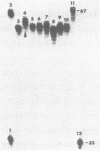Abstract
We have used random oligonucleotide mutagenesis (or saturation mutagenesis) to create a library of point mutations in the alpha 1 protein domain of a Major Histocompatibility Complex (MHC) molecule. This protein domain is critical for T cell and B cell recognition. We altered the MHC class I H-2DP gene sequence such that synthetic mutant alpha 1 exons (270 bp of coding sequence), which contain mutations identified by sequence analysis, can replace the wild type alpha 1 exon. The synthetic exons were constructed from twelve overlapping oligonucleotides which contained an average of 1.3 random point mutations per intact exon. DNA sequence analysis of mutant alpha 1 exons has shown a point mutant distribution that fits a Poisson distribution, and thus emphasizes the utility of this mutagenesis technique to "scan" a large protein sequence for important mutations. We report our use of saturation mutagenesis to scan an entire exon of the H-2DP gene, a cassette strategy to replace the wild type alpha 1 exon with individual mutant alpha 1 exons, and analysis of mutant molecules expressed on the surface of transfected mouse L cells.
Full text
PDF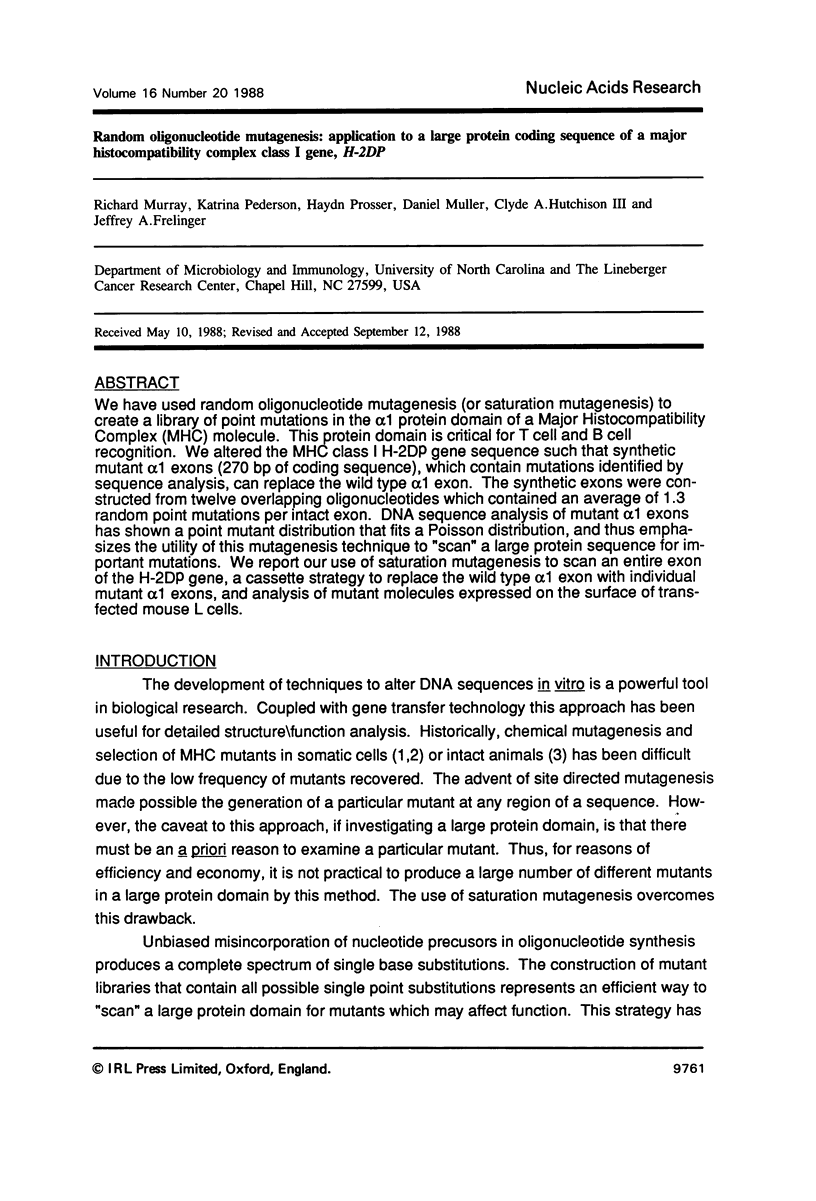
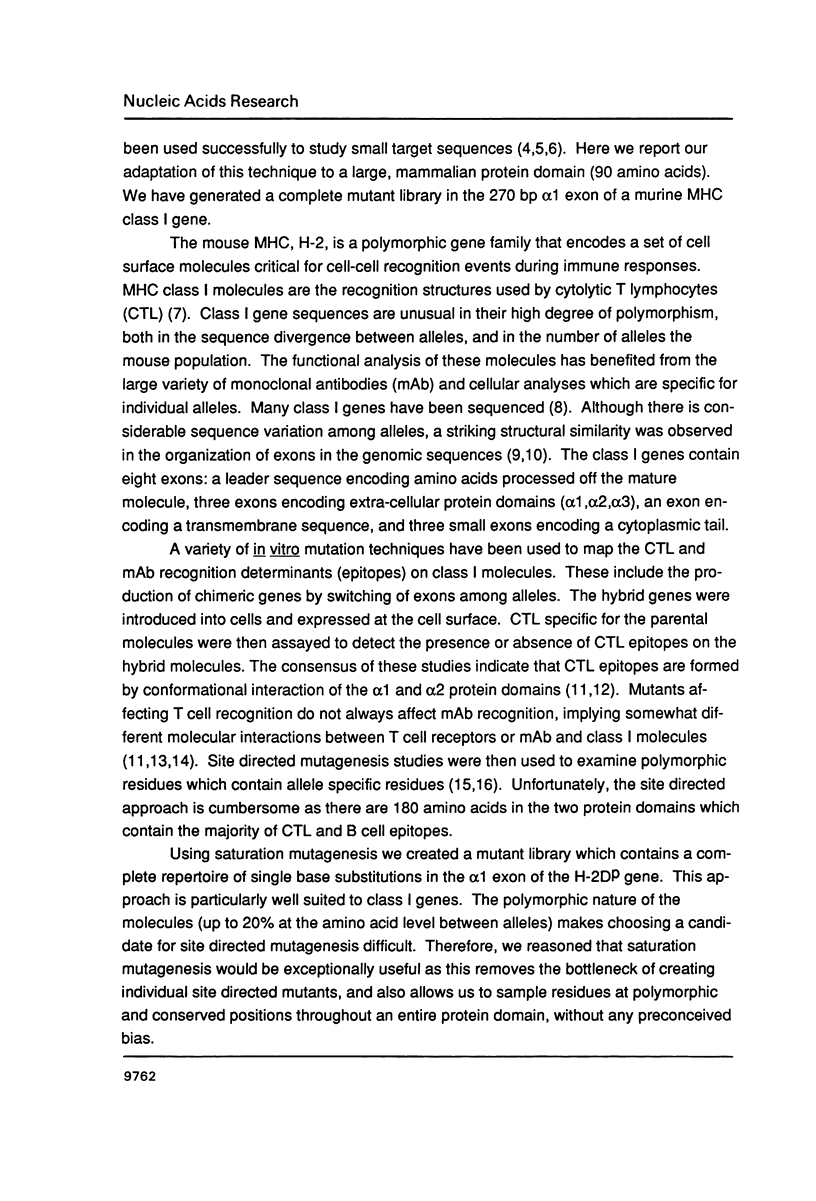
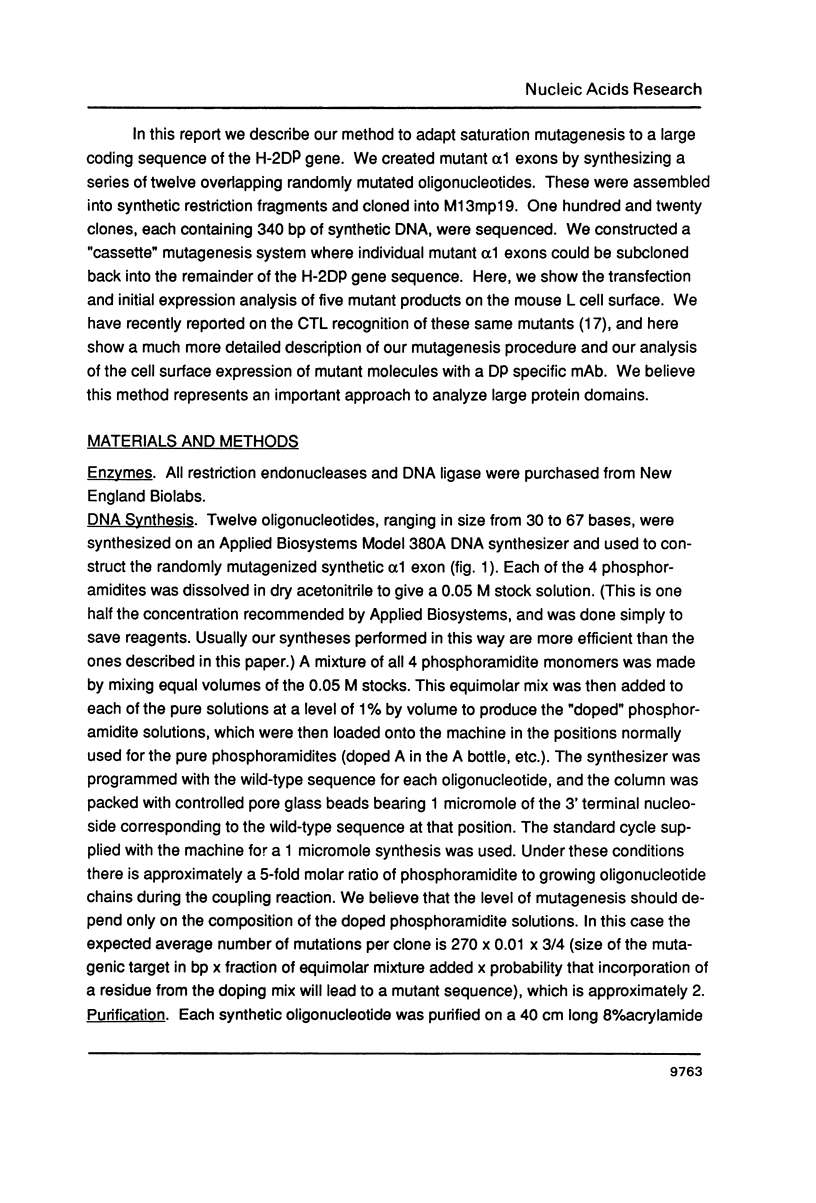
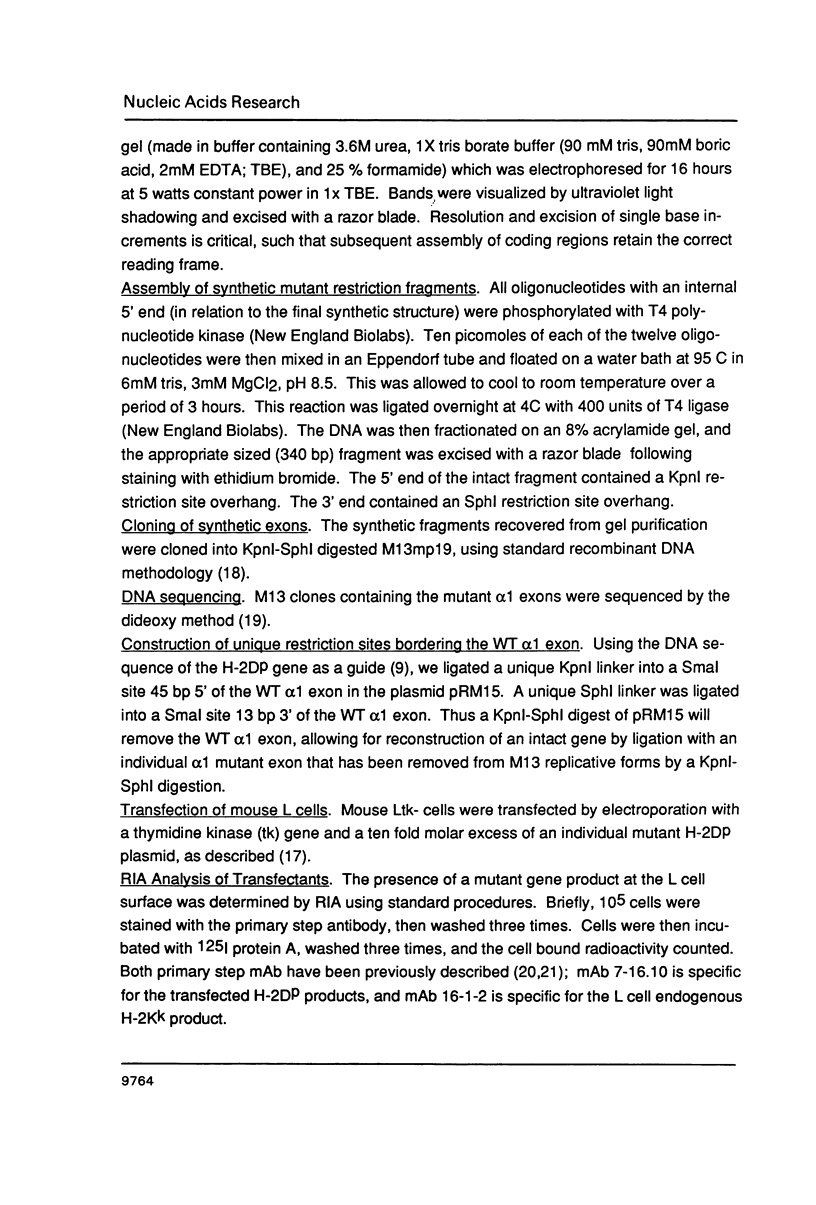
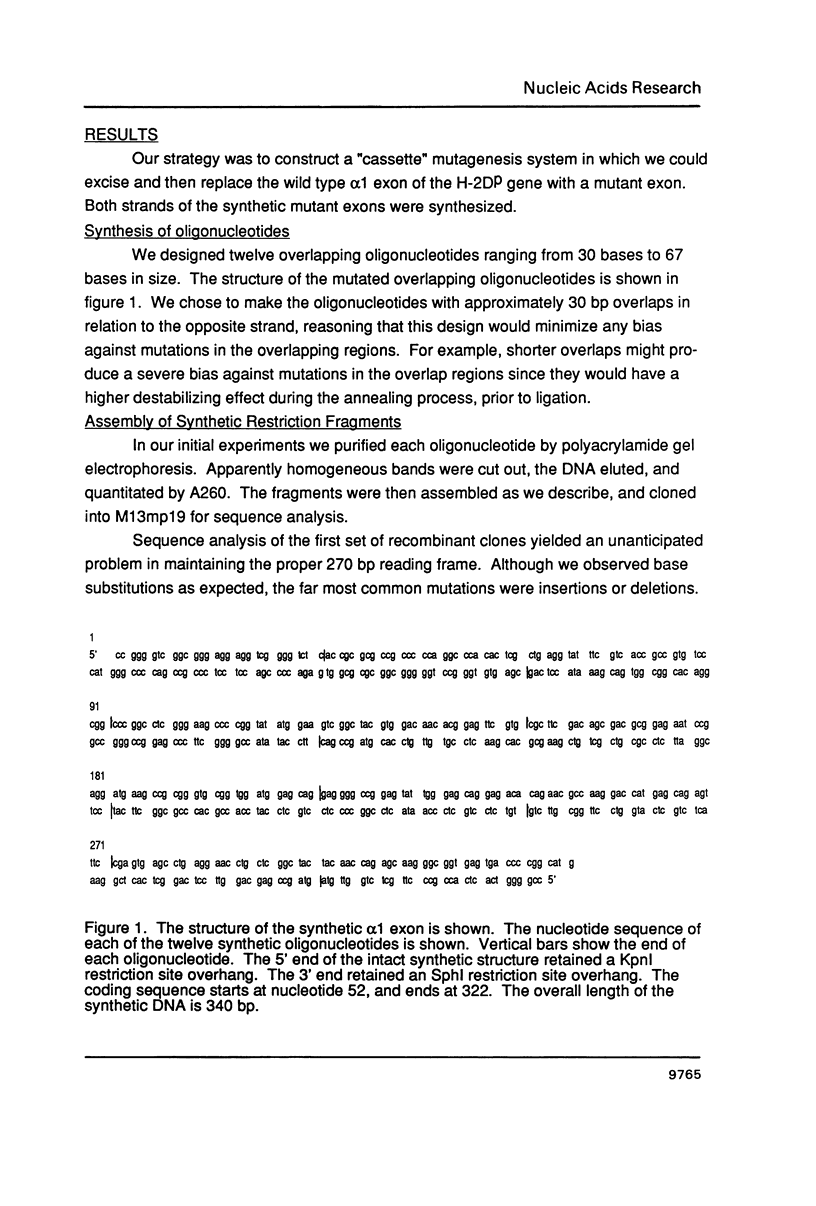
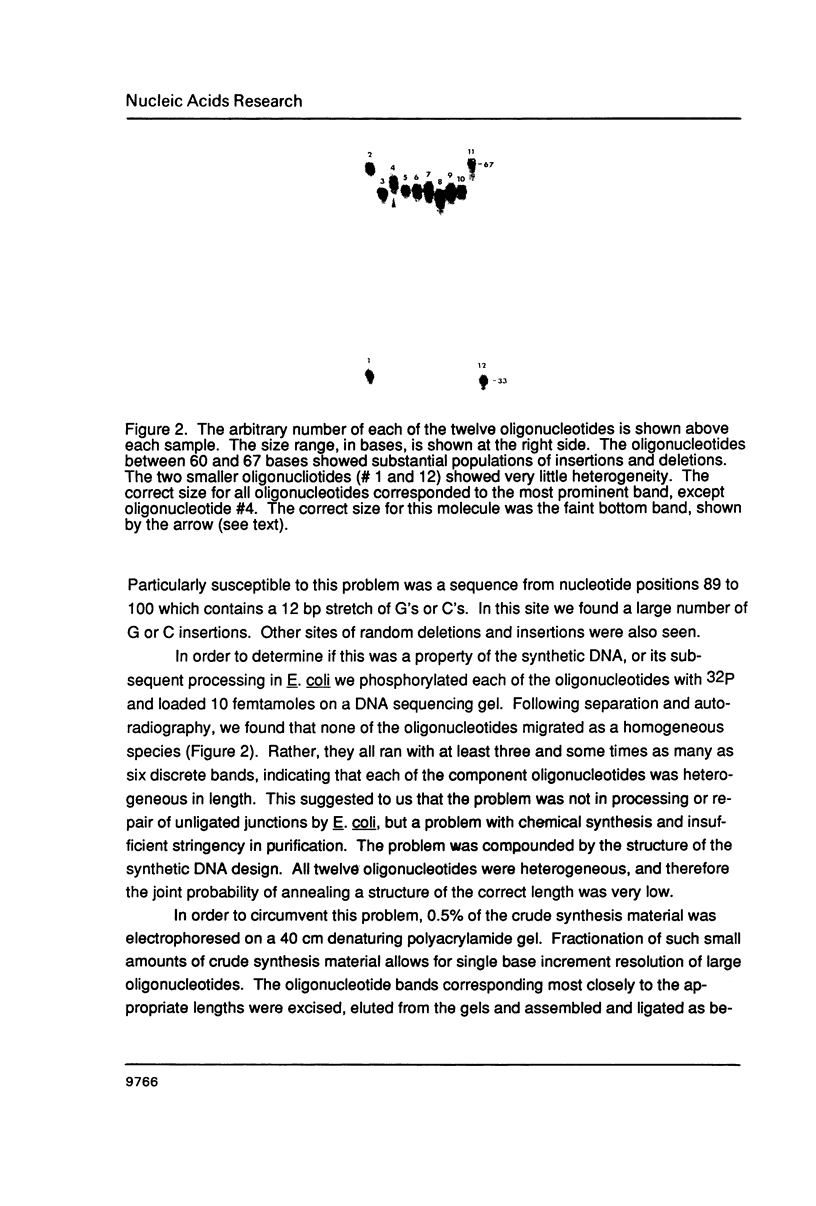
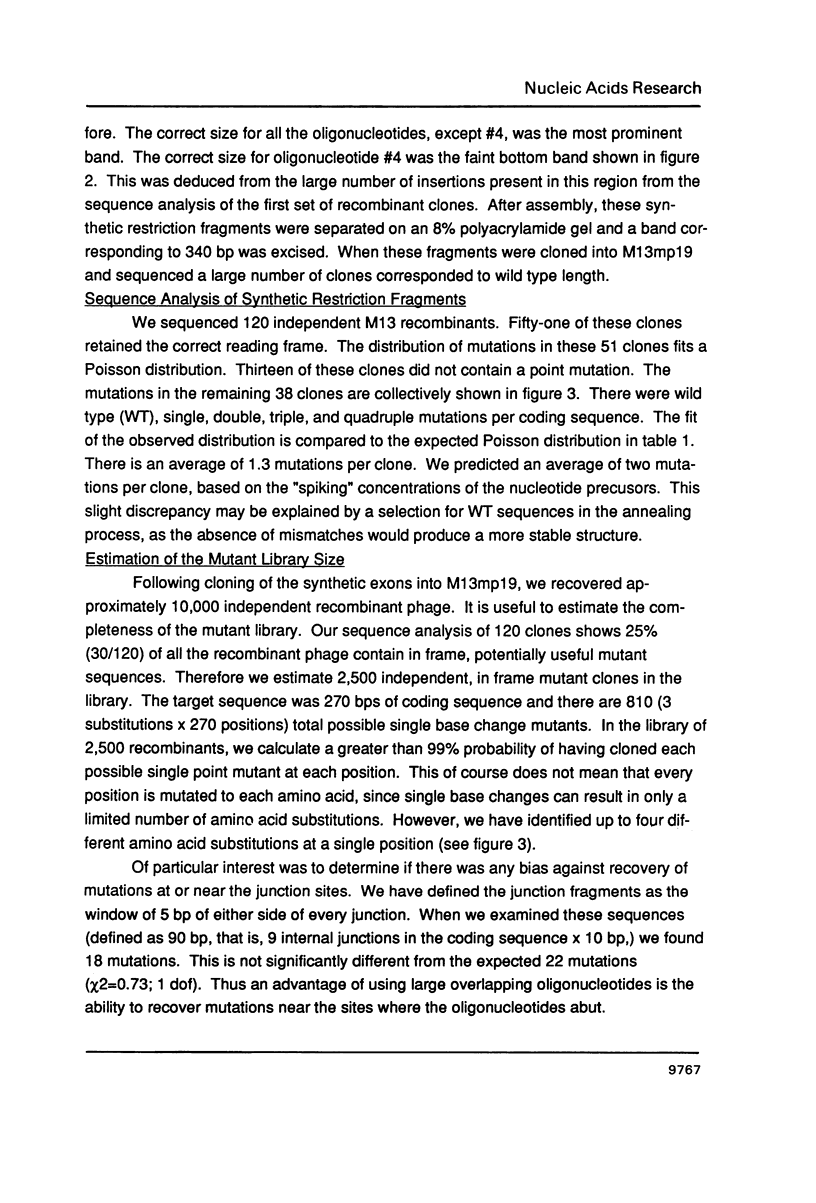
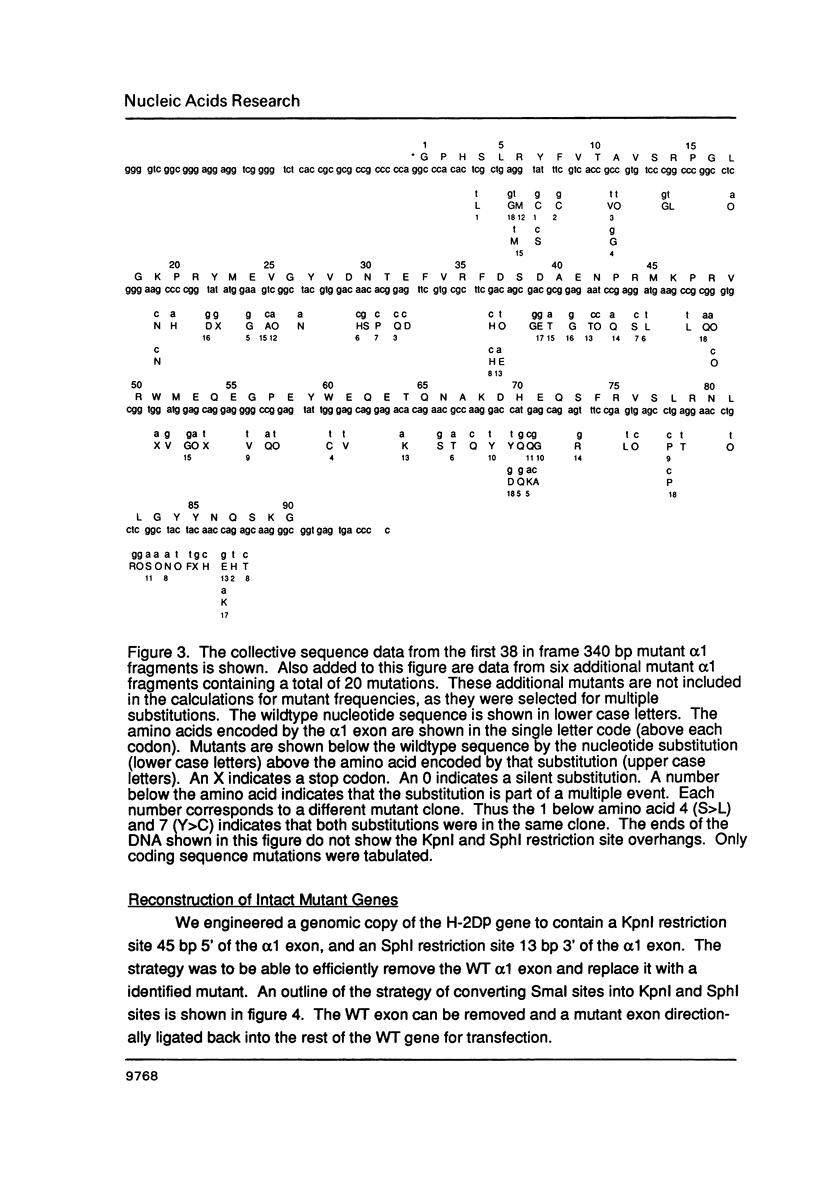
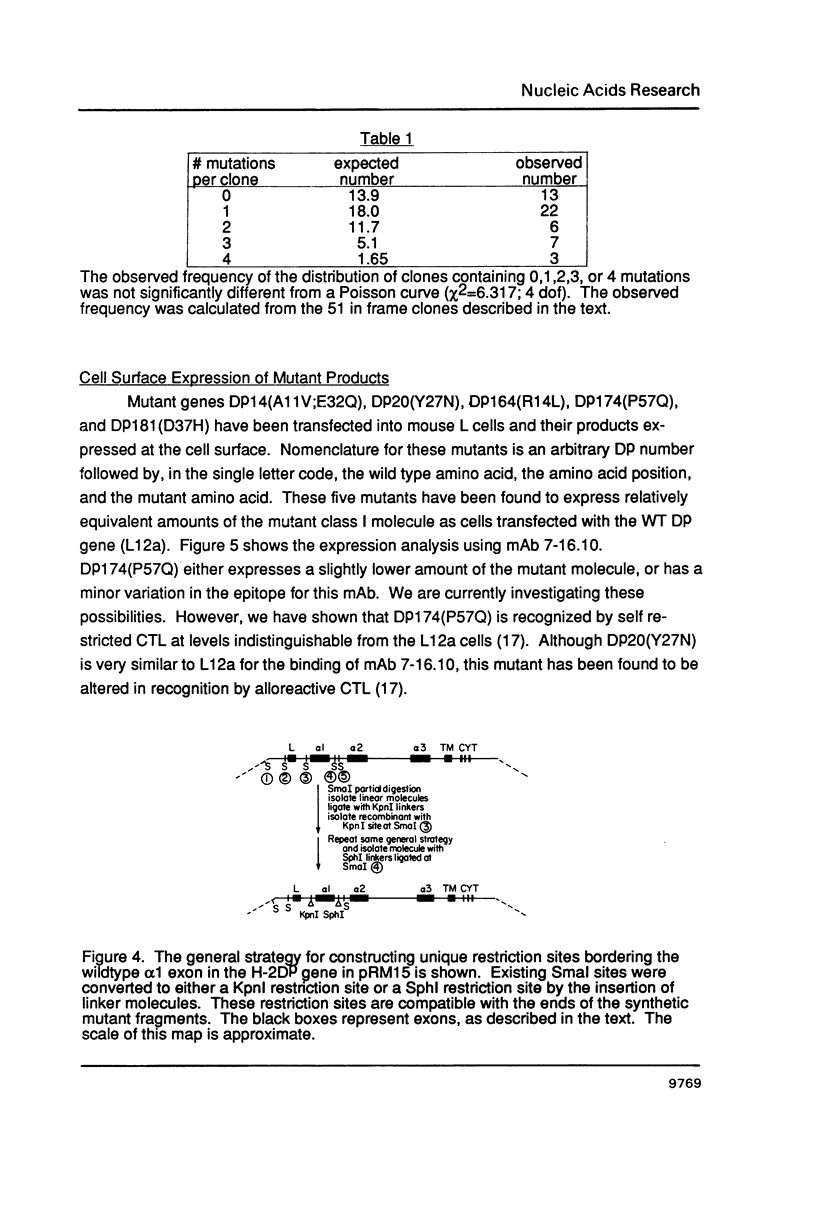
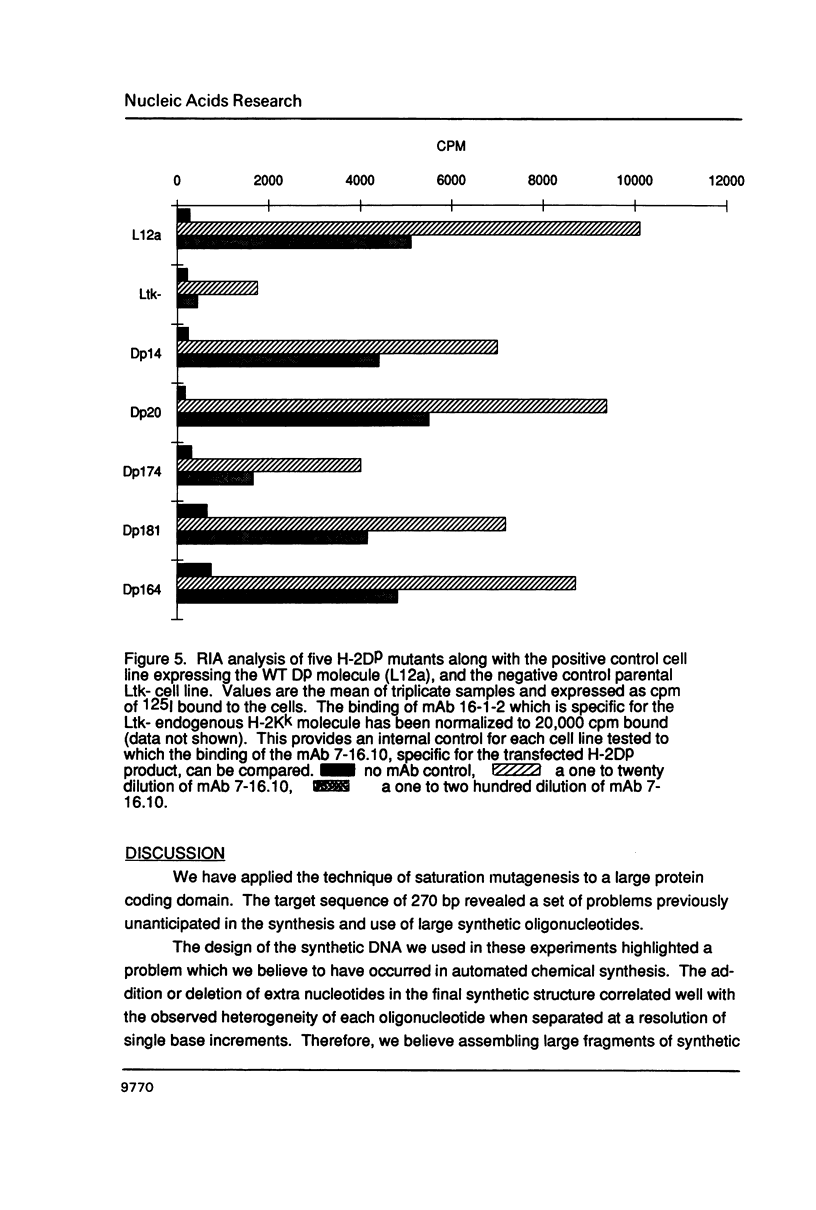
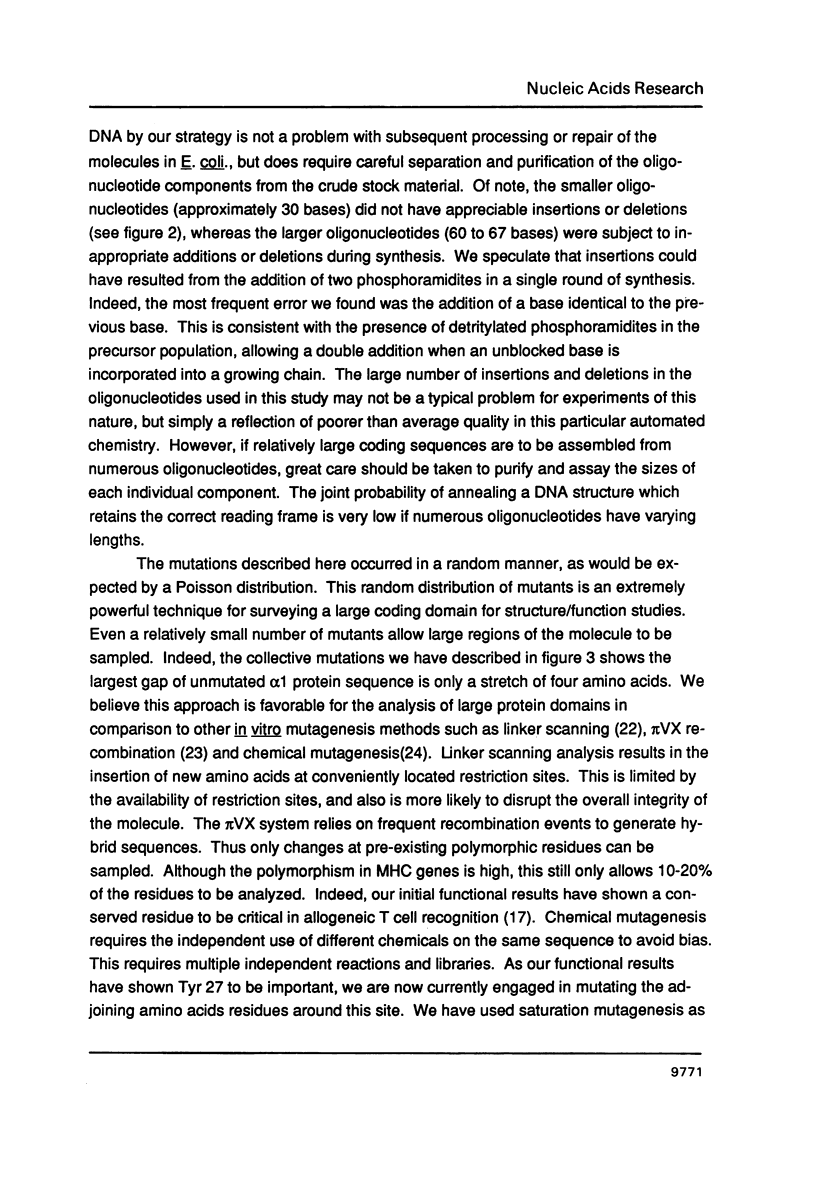
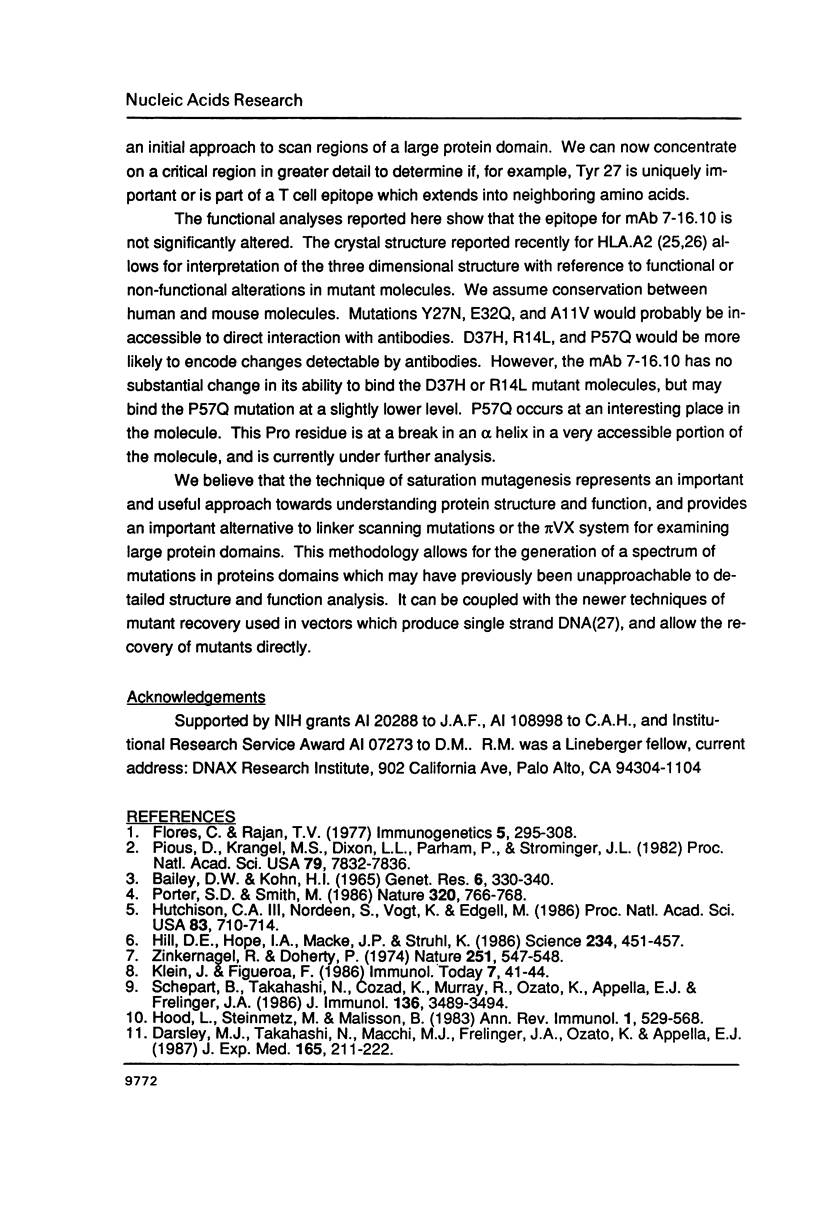

Images in this article
Selected References
These references are in PubMed. This may not be the complete list of references from this article.
- Abastado J. P., Darche S., Godeau F., Cami B., Kourilsky P. Intramolecular recombination between partially homologous sequences in Escherichia coli and Xenopus laevis oocytes. Proc Natl Acad Sci U S A. 1987 Sep;84(18):6496–6500. doi: 10.1073/pnas.84.18.6496. [DOI] [PMC free article] [PubMed] [Google Scholar]
- Bailey D. W., Kohn H. I. Inherited histocompatibility changes in progeny of irradiated and unirradiated inbred mice. Genet Res. 1965 Nov;6(3):330–340. doi: 10.1017/s0016672300004225. [DOI] [PubMed] [Google Scholar]
- Bankier A. T., Weston K. M., Barrell B. G. Random cloning and sequencing by the M13/dideoxynucleotide chain termination method. Methods Enzymol. 1987;155:51–93. doi: 10.1016/0076-6879(87)55009-1. [DOI] [PubMed] [Google Scholar]
- Bjorkman P. J., Saper M. A., Samraoui B., Bennett W. S., Strominger J. L., Wiley D. C. Structure of the human class I histocompatibility antigen, HLA-A2. Nature. 1987 Oct 8;329(6139):506–512. doi: 10.1038/329506a0. [DOI] [PubMed] [Google Scholar]
- Bjorkman P. J., Saper M. A., Samraoui B., Bennett W. S., Strominger J. L., Wiley D. C. The foreign antigen binding site and T cell recognition regions of class I histocompatibility antigens. Nature. 1987 Oct 8;329(6139):512–518. doi: 10.1038/329512a0. [DOI] [PubMed] [Google Scholar]
- Cowan E. P., Jelachich M. L., Coligan J. E., Biddison W. E. Site-directed mutagenesis of an HLA-A3 gene identifies amino acid 152 as crucial for major-histocompatibility-complex-restricted and alloreactive cytotoxic-T-lymphocyte recognition. Proc Natl Acad Sci U S A. 1987 Jul;84(14):5014–5018. doi: 10.1073/pnas.84.14.5014. [DOI] [PMC free article] [PubMed] [Google Scholar]
- Darsley M. J., Takahashi H., Macchi M. J., Frelinger J. A., Ozato K., Appella E. New family of exon-shuffled recombinant genes reveals extensive interdomain interactions in class I histocompatibility antigens and identifies residues involved. J Exp Med. 1987 Jan 1;165(1):211–222. doi: 10.1084/jem.165.1.211. [DOI] [PMC free article] [PubMed] [Google Scholar]
- Evans G. A., Margulies D. H., Shykind B., Seidman J. G., Ozato K. Exon shuffling: mapping polymorphic determinants on hybrid mouse transplantation antigens. Nature. 1982 Dec 23;300(5894):755–757. doi: 10.1038/300755a0. [DOI] [PubMed] [Google Scholar]
- Harmon R. C., Stein N., Frelinger J. A. Monoclonal antibodies reactive with H-2 determinants. Immunogenetics. 1983;18(5):541–545. doi: 10.1007/BF00364395. [DOI] [PubMed] [Google Scholar]
- Heffron F., So M., McCarthy B. J. In vitro mutagenesis of a circular DNA molecule by using synthetic restriction sites. Proc Natl Acad Sci U S A. 1978 Dec;75(12):6012–6016. doi: 10.1073/pnas.75.12.6012. [DOI] [PMC free article] [PubMed] [Google Scholar]
- Hill D. E., Hope I. A., Macke J. P., Struhl K. Saturation mutagenesis of the yeast his3 regulatory site: requirements for transcriptional induction and for binding by GCN4 activator protein. Science. 1986 Oct 24;234(4775):451–457. doi: 10.1126/science.3532321. [DOI] [PubMed] [Google Scholar]
- Hood L., Steinmetz M., Malissen B. Genes of the major histocompatibility complex of the mouse. Annu Rev Immunol. 1983;1:529–568. doi: 10.1146/annurev.iy.01.040183.002525. [DOI] [PubMed] [Google Scholar]
- Hutchison C. A., 3rd, Nordeen S. K., Vogt K., Edgell M. H. A complete library of point substitution mutations in the glucocorticoid response element of mouse mammary tumor virus. Proc Natl Acad Sci U S A. 1986 Feb;83(3):710–714. doi: 10.1073/pnas.83.3.710. [DOI] [PMC free article] [PubMed] [Google Scholar]
- Kanda T., LaPan K., Takahashi H., Appella E., Frelinger J. A. The alpha 1 and alpha 2 domains of H-2 class I molecules interact to form unique epitopes. Immunogenetics. 1987;25(2):110–115. doi: 10.1007/BF00364276. [DOI] [PubMed] [Google Scholar]
- Kronenberg M., Siu G., Hood L. E., Shastri N. The molecular genetics of the T-cell antigen receptor and T-cell antigen recognition. Annu Rev Immunol. 1986;4:529–591. doi: 10.1146/annurev.iy.04.040186.002525. [DOI] [PubMed] [Google Scholar]
- Kunkel T. A. Rapid and efficient site-specific mutagenesis without phenotypic selection. Proc Natl Acad Sci U S A. 1985 Jan;82(2):488–492. doi: 10.1073/pnas.82.2.488. [DOI] [PMC free article] [PubMed] [Google Scholar]
- Murray R., Hutchison C. A., 3rd, Frelinger J. A. Saturation mutagenesis of a major histocompatibility complex protein domain: identification of a single conserved amino acid important for allorecognition. Proc Natl Acad Sci U S A. 1988 May;85(10):3535–3539. doi: 10.1073/pnas.85.10.3535. [DOI] [PMC free article] [PubMed] [Google Scholar]
- Myers R. M., Lerman L. S., Maniatis T. A general method for saturation mutagenesis of cloned DNA fragments. Science. 1985 Jul 19;229(4710):242–247. doi: 10.1126/science.2990046. [DOI] [PubMed] [Google Scholar]
- Ozato K., Mayer N., Sachs D. H. Hybridoma cell lines secreting monoclonal antibodies to mouse H-2 and Ia antigens. J Immunol. 1980 Feb;124(2):533–540. [PubMed] [Google Scholar]
- Pious D., Krangel M. S., Dixon L. L., Parham P., Strominger J. L. HLA antigen structural gene mutants selected with an allospecific monoclonal antibody. Proc Natl Acad Sci U S A. 1982 Dec;79(24):7832–7836. doi: 10.1073/pnas.79.24.7832. [DOI] [PMC free article] [PubMed] [Google Scholar]
- Porter S. D., Smith M. Homoeo-domain homology in yeast MAT alpha 2 is essential for repressor activity. Nature. 1986 Apr 24;320(6064):766–768. doi: 10.1038/320766a0. [DOI] [PubMed] [Google Scholar]
- Salter R. D., Clayberger C., Lomen C. E., Krensky A. M., Parham P. In vitro mutagenesis at a single residue introduces B and T cell epitopes into a class I HLA molecule. J Exp Med. 1987 Jul 1;166(1):283–288. doi: 10.1084/jem.166.1.283. [DOI] [PMC free article] [PubMed] [Google Scholar]
- Schepart B. S., Takahashi H., Cozad K. M., Murray R., Ozato K., Appella E., Frelinger J. A. The nucleotide sequence and comparative analysis of the H-2Dp class I H-2 gene. J Immunol. 1986 May 1;136(9):3489–3495. [PubMed] [Google Scholar]
- Zinkernagel R. M., Doherty P. C. Immunological surveillance against altered self components by sensitised T lymphocytes in lymphocytic choriomeningitis. Nature. 1974 Oct 11;251(5475):547–548. doi: 10.1038/251547a0. [DOI] [PubMed] [Google Scholar]



